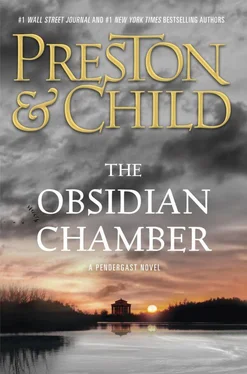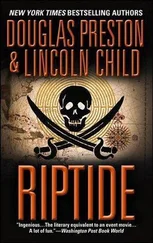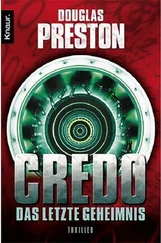“It is most urgent.”
“That’s the way it always is, too.” An exaggerated sigh. “Okay, what’s on your mind?”
“You know my chauffeur, Proctor?”
“Of course. Ex-military, in your unit at one time if I’m not mistaken, first name—”
“Very good. He’s gone missing from the Riverside mansion, as close as I can tell about ten days ago. I need you to track him down for me.”
“Hey, that actually sounds like fun. And when I’m done, maybe you can do something for me? There’s this new FBI toy that I’ve been coveting, a cellular duplexer that disguises—”
“Whatever you desire. Just find Proctor — and keep me informed. Thank you, Mime.” And Pendergast slipped the phone back in his pocket. Then he glanced around one more time.
Despite the deserted look of the room, D’Agosta had seen Constance in the house just this morning — in the presence of Diogenes. D’Agosta had told him Diogenes was carrying a suitcase. And Constance had been wearing a hat. This was something she rarely did — and only when traveling.
Diogenes. That he had survived the plunge into the volcano at Stromboli seemed impossible. But he had nevertheless been in this very house that morning, and he could have only one possible motive: revenge. Revenge on Pendergast, and especially on Constance, who had pushed him into the volcano almost four years ago.
But something wasn’t right. His questioning of D’Agosta that morning had raised certain discrepancies — curious, unsettling discrepancies that Pendergast found himself unable to account for.
He opened the door to Constance’s walk-in closet. Although she had an extensive wardrobe, it was obvious to Pendergast that a number of items were missing.
He stood quietly, thinking. It had been twenty-four days since the struggle in Massachusetts when he’d been swept out to sea. Clearly, a lot must have transpired in his absence — and all of it troubling. Why would Proctor have left the house, abandoning Constance? This was the one thing the man would never, ever do. Where had he gone? Why hadn’t he returned? Despite the request he’d made of Mime, Pendergast feared that Proctor might be dead at the hands of Diogenes. What had Constance been doing, alone, in the empty house?
But strangest of all: exactly what sort of scene had D’Agosta stumbled upon when he entered the mansion shortly after eight that very morning? His description of what transpired made little sense.
Two scenarios were possible. The first was that Diogenes had been caught in the act of abducting Constance for purposes of revenge, directed at her, or him, or both. But her demeanor, dress, and actions, as described by D’Agosta, didn’t fit this scenario.
The second scenario… the one that best fit the facts… was too perverse, and too terrible, even to consider.
He broke his reverie suddenly, going into action. He dashed from the room and began an intense, methodical search of the mansion. He climbed up into the rambling attic and from there moved thoroughly and rapidly down through the house, looking for information, any information, that could help solve the riddle of the empty structure. His mind was fixated on the fact that, even now, the clock was ticking, ticking down to her unknown fate…
Sixteen hours later, he was in the sub-basement, sitting at the library worktable in Constance’s small suite of rooms. He now understood a great deal: most significantly, that this was where she had been living for perhaps the past two weeks. Four items were ranged on the table before him: an orchid; a book of love poems by Catullus, with a marginal note in a handwriting all too familiar; a holograph sheet music score, dedicated to Constance; and a Tibetan t’angka painting, at whose center was the representation of a god-child whose features — once again — were disquietingly familiar.
Pendergast felt a numbness beyond anything he had experienced before. He had come to one conclusion: Constance had yielded to a subtle, inexorable, and beautifully executed campaign of courtship.
It was inconceivable that Constance, of all people, could be taken in, deceived, won over by such a campaign. And yet all the evidence suggested this is what had happened.
Pendergast had to admit to himself that, despite his unusual insight into the criminal side of human nature, he had frequently been at sea when it came to understanding women and the complexities of intimate relationships. And of all the women he had known, Constance, and her strong, violent passions, was the most enigmatic.
Pendergast looked around the room, his figure quiescent after hours of ceaseless activity, pale eyes glittering as they returned to the four items on the table. It still seemed impossible.
There was, he realized, one way to be sure. He removed the windbreaker and — without touching them — wrapped the sheet music and the book of Catullus poetry carefully inside it, then stood up and — after retrieving a hairbrush from Constance’s bedroom — made his way back up to the main library.
Accessing a laptop computer hidden behind one of the wooden panels, he logged into the NYPD secure website and, accessing the fingerprint database, brought up a series of latents for Diogenes, which had been collected when his brother had been wanted for kidnapping and the theft of a diamond known as Lucifer’s Heart.
With Diogenes’s prints displayed on the laptop screen, he then retrieved a portable forensic fingerprinting kit and — using print powder and lifting tape — dusted the sheet music and the book of Catullus poetry. He was able to retrieve two different sets of latents. One of those sets belonged to Diogenes.
Constance Greene’s fingerprints were in no database, official or otherwise. Turning to the hairbrush, Pendergast lifted samples of the lone sets of prints he found on it and examined them, comparing them with the other set of prints on the book and sheet music. They were a match. Proof that it was Diogenes, and no one else, who had courted Constance while Pendergast was prisoner aboard the drug smuggler’s boat.
One other test remained. Pendergast felt afraid to undertake it.
He sat in the darkened library for a long time. Finally, accessing the NYPD database once again, he brought up the series of latents the police had lifted from the pieces of the Ming vase that had been smashed against the back of D’Agosta’s head.
He knew the vase well. It was rare and fragile. Its impact might stun a man but not kill him. The NYPD photographs made it clear that the vase — lip, neck, handle, delicate body — had been shattered into a great many pieces. Only one part of the vase — the foot — was intact.
Pendergast brought up the suite of fingerprints lifted from the foot. Many prints had been found, but one set overlaid all the others — and the placement of those prints indicated that the last person who had taken up the vase had gripped it in a particular way: for use as a weapon.
Those prints belonged to Constance.
His hands slid off the laptop’s keyboard and he shuddered. Constance had been courted by his brother. Knowing everything she knew about Diogenes, and despite the troubled history between them, she had succumbed and gone off with him. D’Agosta had interrupted their departure, and she’d knocked him senseless with a vase.
Unfamiliar emotions flooded through him: panic, confusion, horror — and underneath it, a sickening feeling of jealousy. He had to do something — immediately. But what? What was Constance doing at this moment? Was she still alive? Images, vile images, intruded themselves on his consciousness. Was she — God forbid — with his brother now, at this very moment? His thoughts went back to the unexpected confrontation with Constance he’d had in his room at the Exmouth inn. Had his awkward handling of that private moment somehow helped lead her into the arms of his hated brother?
Читать дальше











